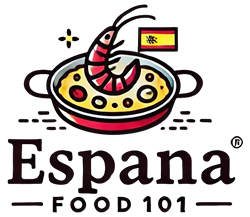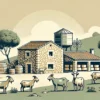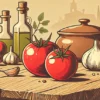Catalonian cuisine boasts a rich tradition, and one of its most treasured dishes is Escudella. Often called the “grandfather of all Catalan soups,” this hearty stew symbolizes more than just a meal; it represents the warmth and comfort of Catalonian culture. At its core, Escudella is a mix of meats, vegetables, and noodles or rice, cooked in a flavorful broth. Its origins date back centuries, making it a quintessential part of Catalonian culinary heritage. Today, it’s most commonly enjoyed during the colder months and is a staple on Catalan tables, especially around the holiday season.
The Cultural Significance of Escudella
In Catalonia, food has always been more than sustenance. Meals are about community, family, and tradition. Escudella, particularly, holds a unique place in the hearts of the Catalan people because it’s more than just a stew; it’s a reflection of their history. Traditionally served on Christmas Day, Escudella brings families together. Preparing this dish often takes several hours, involving different meats, bones, and vegetables, all simmering in a pot, filling homes with an inviting aroma that signals the season of warmth and togetherness. It’s not just a meal—it’s a symbol of unity and shared moments.
Helpful Hint:
When making Escudella, slow cooking is key. Allow the meats and bones to simmer for at least two hours. This gives the broth its deep, rich flavor.
What Are the Key Ingredients in Escudella?
Escudella is a versatile dish, but its most iconic version, Escudella i Carn d’Olla, features some essential ingredients. Here’s a breakdown of what you’ll typically find in this hearty stew:
- Meat: Various types of meats are used, including beef, pork, chicken, and even some bones for flavor. Meatballs, known as pilota, are also a traditional addition.
- Vegetables: Potatoes, cabbage, leeks, carrots, and turnips are commonly used, contributing to the stew’s rustic and earthy flavor.
- Broth: The broth is usually made from simmering the meats and bones, creating a rich and savory base for the dish.
- Carbs: Depending on the version, you might find rice, pasta (like small noodles), or a combination of both, adding an extra level of heartiness.
How Is Escudella Traditionally Prepared?
Preparing Escudella is a labor of love. First, a variety of meats and bones are simmered for hours, creating a deep broth. Vegetables like cabbage, carrots, and leeks are then added, followed by rice or noodles. The dish is often served in two parts: first, the broth with noodles or rice, and then the meats and vegetables are eaten as a second course. This slow-cooking process is key to ensuring the stew is as flavorful and comforting as possible.
Why Is Escudella So Popular During the Holidays?
There’s something incredibly comforting about a warm bowl of Escudella on a cold winter day, which is why it’s traditionally served on Christmas in Catalonia. The dish brings people together—families gather around the table, sharing stories and creating memories, with the aromatic stew at the heart of the celebration. The preparation itself is a communal activity, often involving multiple family members working together to create this traditional meal. In many ways, it’s more than just food; it’s a reminder of Catalonia’s strong sense of family and community.
How Has Escudella Evolved Over the Years?
Like any traditional dish, Escudella has evolved with time. While the essential components remain unchanged, many modern Catalans put their own spin on the dish. Some add new vegetables, switch out meats, or even create vegetarian versions. Despite these modern twists, the core of the dish—a rich, hearty stew that brings people together—remains the same.
Helpful Hint:
For a modern take on Escudella, try substituting lentils or chickpeas for the traditional meats. This creates a vegetarian-friendly version that still captures the essence of the dish.
Regional Variations of Escudella in Catalonia
| Region | Unique Ingredients | Cooking Techniques |
|---|---|---|
| Barcelona | Pork sausages, white beans | Broth simmered longer for added depth |
| Pyrenees | Wild mushrooms, root vegetables | Slow-cooked over a wood fire for smoky flavor |
| Tarragona | Fennel, rice | Cooked with more herbs for an aromatic broth |
| Girona | Chickpeas, kale | Incorporates legumes for extra heartiness |
Does Every Family Have Their Own Escudella Recipe?
In Catalonia, it’s often said that no two bowls of Escudella are alike. Each family has their own twist on the recipe, passed down through generations. Some may use more beef, while others prefer pork or chicken. Even the vegetables and spices can vary, with some families opting for a heartier version with beans or extra potatoes. These small variations make each family’s Escudella unique, adding a layer of personal tradition to the dish.
Conclusion: Escudella as a Pillar of Catalan Identity
Escudella isn’t just a meal; it’s a symbol of Catalonian heritage, family, and tradition. From its rich history to its variations across families, it represents the warmth and comfort that food can bring. Whether enjoyed during the holidays or on a chilly evening, this hearty stew continues to be a beloved staple of Catalan cuisine, connecting generations and preserving a piece of the region’s cultural identity.
What Makes Escudella Unique Compared to Other Spanish Stews?
Spain is known for its variety of stews, such as Cocido Madrileño from Madrid and Puchero Andaluz from Andalusia, but Escudella stands out for several reasons. Firstly, it’s often seen as the first recorded soup in European history, making it not only a culinary gem but also a historical one. Another unique feature is its two-part serving method. While most Spanish stews are served as one dish, Escudella separates the broth from the meats and vegetables, offering two distinct experiences in one meal. This ritual of eating adds a layer of tradition that other stews don’t quite match.
Helpful Hint:
Want to experience Escudella like a true Catalan? Serve it in two courses: first the broth with pasta or rice, and then the meats and vegetables. It adds an authentic touch to your meal.
How Does Escudella Represent Catalonian Self-Sufficiency?
Catalonians have long prided themselves on their self-sufficiency, and Escudella is a perfect representation of that. Historically, this dish was made with whatever ingredients were readily available, often from the farm or local market. The combination of meats, bones, and vegetables was practical and resourceful, ensuring nothing went to waste. Over time, this approach became ingrained in the Catalan way of cooking—taking simple, accessible ingredients and turning them into something deeply nourishing and flavorful. This tradition continues today, with modern Catalans using locally sourced ingredients to prepare their beloved Escudella.
What Are the Health Benefits of Eating Escudella?
While Escudella is undeniably hearty, it also offers several health benefits. The dish is rich in proteins from the various meats used, along with a good dose of fiber from the vegetables. The broth itself is packed with nutrients, thanks to the slow cooking process that extracts all the goodness from the bones and vegetables. Eating Escudella can help provide a balanced meal, offering a mix of vitamins, minerals, and proteins that support overall health, especially during the colder months when the body craves warm, nourishing food.
Stats:
Studies have shown that consuming bone broth, a key component of Escudella, can improve joint health, aid digestion, and strengthen the immune system due to its high collagen content.
How Can You Make Escudella at Home?
Making Escudella at home is a rewarding experience, but it requires time and patience to get it just right. Here’s a basic step-by-step guide to help you recreate this traditional Catalan stew:
- Prepare the Broth: Start by simmering a mix of beef, pork, chicken, and bones in a large pot of water for about two hours. Skim off any impurities that rise to the surface.
- Add Vegetables: Once the broth is rich and flavorful, add chopped cabbage, carrots, leeks, and potatoes. Let everything cook until the vegetables are tender.
- Make the Meatballs: In the meantime, prepare the traditional meatballs (pilota) by mixing minced pork with garlic, parsley, and breadcrumbs. Shape them into small balls and add them to the broth.
- Add Pasta or Rice: Once the meatballs are cooked through, add pasta or rice to the broth, and let it simmer until tender.
- Serve in Two Courses: For an authentic Catalan experience, first serve the broth with the pasta or rice. Then, offer the meats and vegetables as a second course.
By following these steps, you’ll be able to create a rich, satisfying bowl of Escudella, perfect for family gatherings or a cozy night in.
Why Is Escudella More Than Just a Dish?
For Catalonians, Escudella isn’t just food—it’s a celebration of their identity, resilience, and togetherness. The process of making this stew, from simmering the broth to serving it in multiple courses, brings families together in a way that few other dishes do. It’s a reminder of their history, their culture, and the importance of sharing meals with loved ones. This is why Escudella remains a cornerstone of Catalan culinary tradition, cherished for its flavor, but even more for what it represents.
How Has Modern Catalonian Cuisine Embraced Escudella?
Despite the influx of modern cooking techniques and international influences, Escudella has remained a beloved staple in Catalonian households. Many chefs have embraced this traditional dish, reimagining it with new ingredients and presentations. For instance, some modern versions of Escudella include innovative touches like wild mushrooms, saffron, or artisanal sausages, adding a contemporary twist to a classic recipe. However, even with these adaptations, the essence of Escudella—its heartiness, its warmth, and its cultural significance—remains intact.
Helpful Hint:
If you’re feeling adventurous, try making a modern version of Escudella by adding a splash of white wine or experimenting with different herbs like thyme or rosemary.
Where Can You Try the Best Escudella in Catalonia?
While many Catalans take pride in their homemade versions of Escudella, several restaurants across Catalonia have gained a reputation for serving exceptional bowls of this traditional stew. In Barcelona, you can visit Can Culleretes, one of the oldest restaurants in the city, where Escudella is a staple on the menu during the colder months. Another great spot is Ca l’Isidre, a restaurant known for blending tradition with innovation, often offering a refined take on Escudella. For a more rustic experience, head to the Pyrenees, where many small village restaurants serve hearty, homemade versions of the dish.
How to Pair Wine with Escudella
Wine pairing is an important aspect of Catalan dining, and Escudella is no exception. Given the richness of the dish, a robust red wine often complements the flavors best. Try pairing it with a bold Priorat or Montsant, two of Catalonia’s most renowned wine regions. These wines have the depth and body to stand up to the hearty meats and rich broth of Escudella, creating a harmonious balance that elevates the dining experience.
FAQs
Wrapping Up
Escudella is much more than just a hearty stew—it’s a pillar of Catalan culture that has stood the test of time. From its humble origins to its current place as a festive dish, Escudella represents the warmth, togetherness, and culinary history of Catalonia. Its rich broth, tender meats, and seasonal vegetables continue to nourish families and preserve cultural traditions. Whether you’re enjoying it at a restaurant or preparing it at home, Escudella offers a window into the heart of Catalonian cuisine. As you savor each bowl, remember the tradition, history, and love that goes into every bite.







